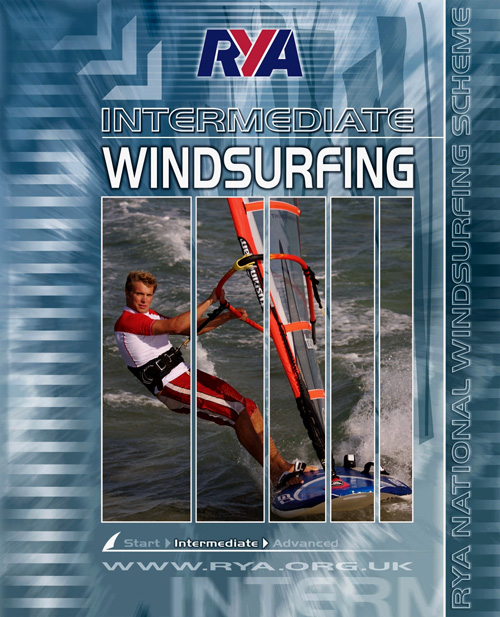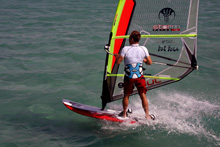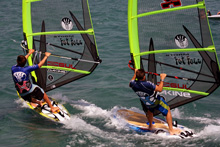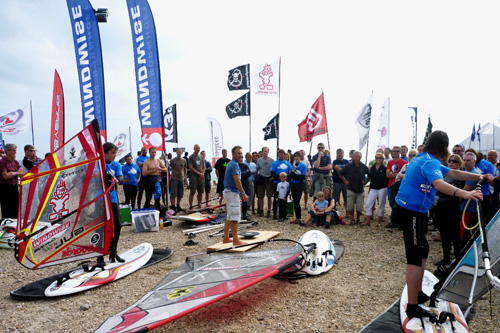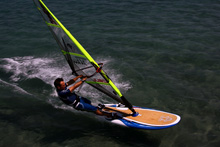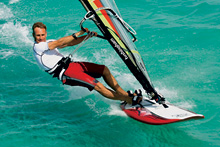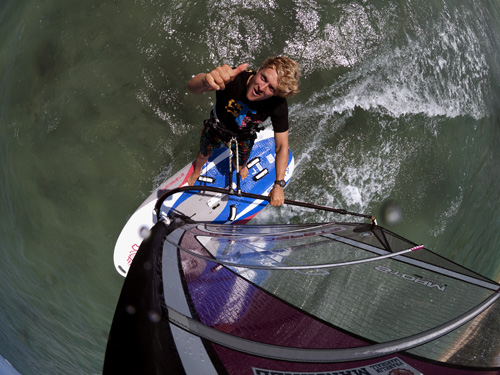
Maybe it was a UK course, overseas holiday or you’ve just bought your first board, but now you’re hooked! So what’s next? Our technique chief, Simon Bornhoft, offers some wise words on what beginners should be focusing their precious time on…
WindWise Beginners’ Guide: What Next? Photos: Windwise / Karen Bornhoft. Words: Simon Bornhoft
WHAT NEXT?
Be warned, windsurfing is addictive! The desire to improve infects and absorbs just about everyone who’s grasped a boom with intent. The adrenaline rush and delight when progress is made creates a hunger for more. But with so much to encounter during the early stages of the sport, people often ask “What should I be concentrating on next?”
While there is no absolute set order, it’s wise to set a few priorities to improve your path of progression. But whatever you do, throw yourself into it with belief, commitment and exaggeration. The difference between being new to the sport and becoming accomplished is down to being more dynamic and determined in your movements. Secondly, don’t be put off by perceived barriers. Just because something initially feels harder doesn’t mean it is. Keep going and you will get it.
So let’s assume that you can sail along in very light winds. Here’s what you need to work on next.
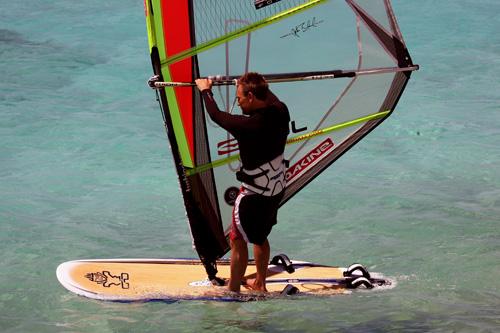
FIRST PRIORITY: LEARN TO SAIL UPWIND WITHOUT A DAGGERBOARD
Being able to sail upwind without a daggerboard is vital. It stops you drifting downwind, which makes it easier to learn tacks and gybes, plus it will prepare you for using smaller boards in the future.
Vision – Look and turn the shoulders upwind.
Trim – Front foot points forward near the edge of the board, tilting and digging the windward rail in.
Opposition – Adopt a ‘7’ shaped stance and keep a good distance from the rig with an extended front arm as you gently sheet in to sail upwind.
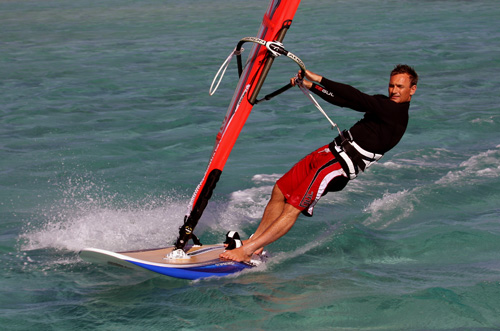
MAIN FOCUS: ‘7’ STANCE
Your STANCE is vital, which, for simplicity’s sake, should resemble the shape of a 7.
So really focus on relaxing and extending those arms and upper body away from the rig. This helps form a strong stable stance to oppose the sail’s power and pull. Get this right early on and everything else becomes much, much easier.
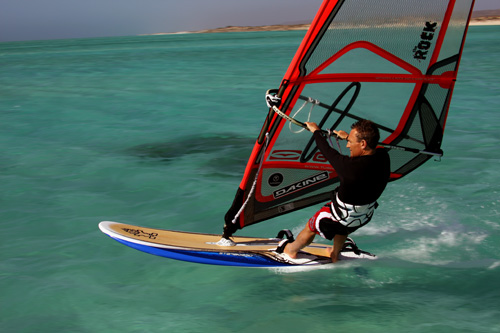
BLASTING TARGET: LEARN TO HARNESS, POWER UP & FOOTSTRAP
Once you can sail back and forth, don’t delay learning to harness. Have the confidence, commitment and belief that ‘yes’, if you use a large enough sail, it will support you. Work on increasing your speed, heading upwind if it ever feels too fast! Check our harness section for some great tips.
FOOTSTRAPS
Once you’re regularly ‘planing in the harness’ (basically going at about 15-20 mph) you’ll want to get into those footstraps for extra security. Adjust them so your little toe pokes right through, following these tips to get in them!
Vision: Look forward, not at the strap.
Trim: Place each foot next to the strap, not on it.
Opposition: When moving your body to unweight either foot, you need to counterbalance with the rig.
Front Strap: Body back, rig forward to unweight and slip the front foot in.
Back Strap: Rig back, body forward to unweight and slip the back foot in.
Power: Keep your weight out and down in the harness to keep the sail sheeted in.
Stance: Form that ‘7’ shaped stance before and after slipping into the straps.

EVERY TIME YOU LEAVE THE SHORE: TRY A BEACHSTART
Beachstarts save energy and are a cool way to leave the shore. Don’t delay, learn straight away and work on doing them deeper and deeper! Get the rig high, flex that rear leg and roll your head under the boom.
Q. WHAT ELSE SHOULD I WORK ON?
A. Don’t just sail up and down – make sure you practice transitions at the end of each run.
The conditions ultimately determine what you might be able to learn on any given day.
LIGHT WINDS
Q. Should I perfect tacks or gybes first?
A: Do both! Especially if the wind is light, sail upwind trying 5-10 tacks, then sail downwind trying 5-10 gybes.
TACK UPWIND
Tacking is easier to learn than gybing, plus it helps you stay upwind.
WISEWORDS: Look where you want to go and always try to move in the opposite direction of the mast/rig. I’d practice the footwork on land too!

GYBE DOWNWIND
Q. What type of gybe should I learn?
A. ‘Non-planing carve gybe’ (NPCG), also known as a ‘step gybe’. This is where the feet change before the rig is rotated over the nose.
NPCGs link directly into stronger wind gybes and help prevent bad habits that can limit your progress in the future.

LANDLUBBER!
It’s worth breaking moves down on land – without falling in!
STRONG WINDS
Q. What should I do if I find it’s just too windy for me?
A. Waterstart!
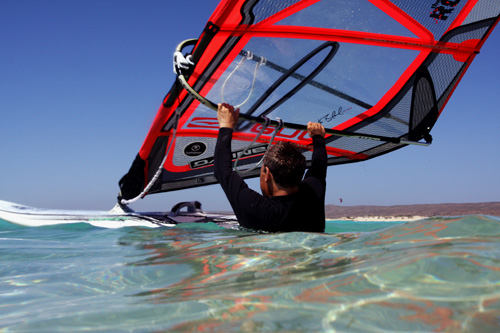
WATERSTART
You can take someone off the street and teach them to waterstart – it’s a technique that has virtually nothing to do with your ‘windsurfing’ ability. If it’s just too windy to sail, seek shallow water and practice flying the rig without your feet on the bottom. You’ll want to learn it some day, but there’s no reason to put it off.
SMALLER BOARDS?
Q. When should I try smaller boards, and should I sell my beginner board?
A. I strongly suggest keeping the beginner board forever. It’s a perfect platform to go back to when you want to practice more advanced moves and techniques in slow motion. It’s time to consider a smaller board when you can comfortably blast in the harness and footstraps.
HARNESSWISE
Learn to lean back and let the harness take the strain!
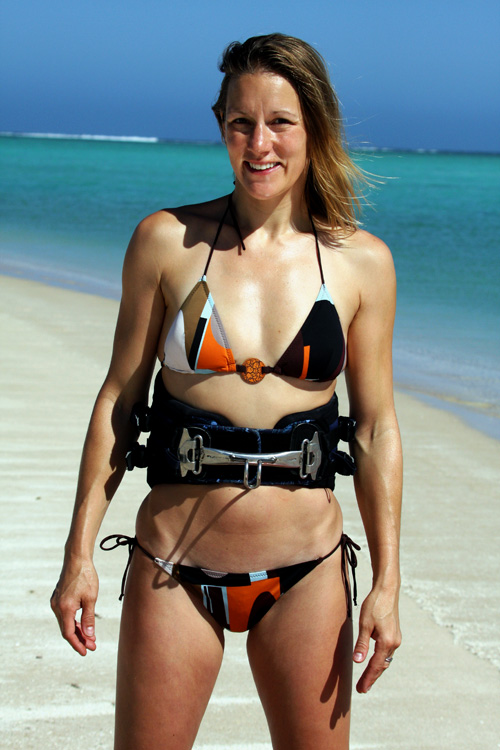
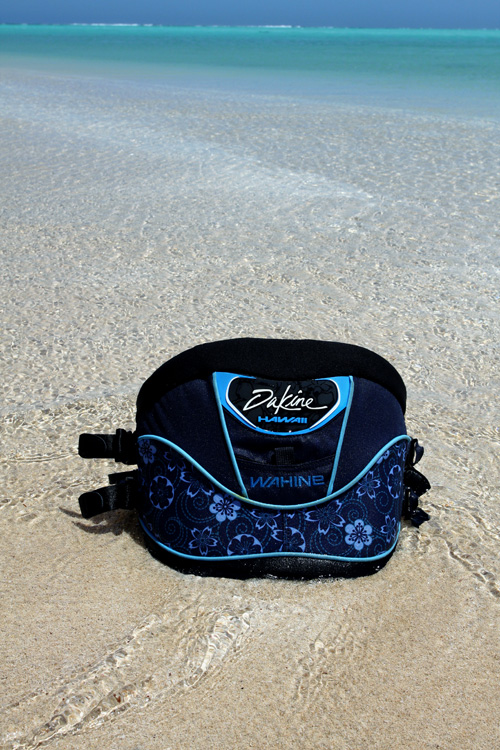
HARNESS
Go for a ‘waist harness’ that fits snug around the body. The best designs have secure fastening belts to stop the harness riding up.

HARNESS LINE LENGTH
Buy harness lines that are ‘elbow to palm of your hand’.
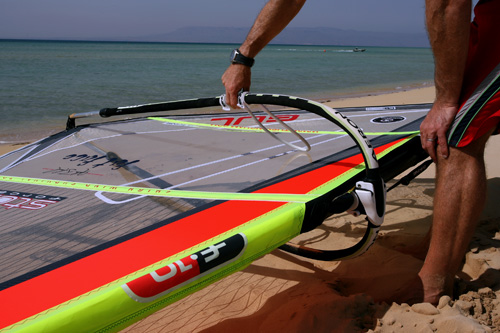
HARNESS LINE POSITIONING
Out of the wind, find a balance point so that the boom is horizontal when you lift it, and place your harness lines just either side of that point. Adjust on the water.
LINES TOO FAR FORWARD
Q. Rear hand pulling?
A. Move the lines a few centimetres back down the boom.
LINES TOO FAR BACK
Q. Front hand pulling?
A. Move the lines a few centimetres forward up the boom.
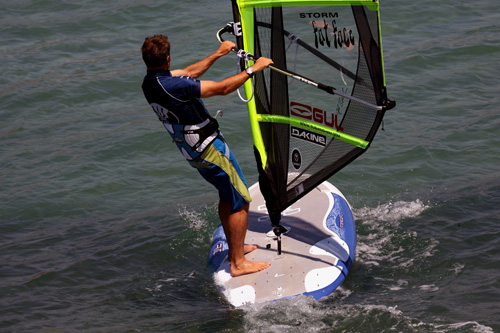
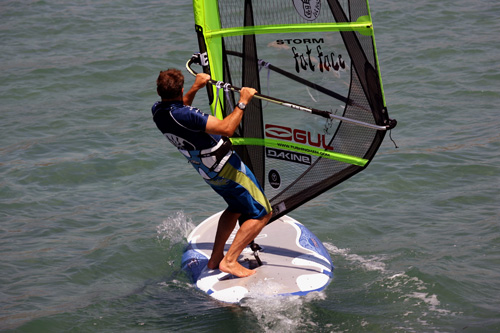
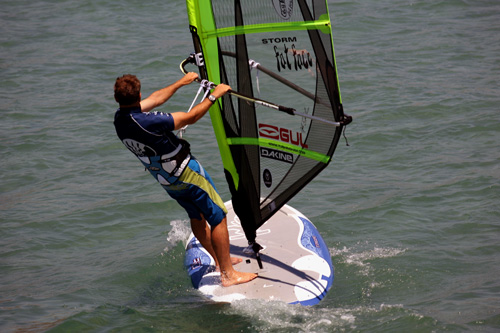
HARNESS HEAVEN
From an outboard position, swing the line towards you by sharply pulling on the boom. Once you’re ‘hooked in’, USE THAT HARNESS! Push out, back and down into the harness with your whole torso, forming a ‘7 shaped’ stance to keep constant tension in the line and relax those arms. Only pull on the arms to release the line.
Finally…
You’ll soon decide whether cruising about on inland waters or venturing onto the sea is right for you. But whatever you choose to do, there are many others doing the same and there’s plenty of fantastic kit to make it incredibly enjoyable. See you out there!
If you have any queries about your windsurfing ask Simon via [email protected]

For Beginner-Intermediate & Advanced courses both in the UK and abroad get wiser by contacting [email protected] For more info check out the SB Intermediate Windsurfing book for all the details on gybes, tacks and loads of other useful techniques to take you to the next stage. www.windwise.net
